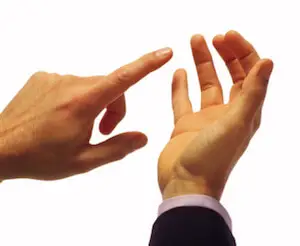The first line of a popular children’s counting rhyme.
Eeny, meeny, miny, mo
What's the meaning of the phrase 'Eeny, meeny, miny, mo'?
What's the origin of the phrase 'Eeny, meeny, miny, mo'?
Of all of the phrases and idioms in the English language ‘eeny, meenie, miny, mo’ must be the one with the widest variety of spellings. I’ve opted for ‘Eeny, meeny, miny, mo’ but there are many others – ‘Eenie, meenie, miney, moe’, ‘Eany, meany, miney, mo’ and so on. Added to that, as far back as the 19th century there have been variants of the rhyme which are so dissimilar to our current version as to be scarcely recognisable – ‘Hana, mana, mona, mike’ (from New York) and ‘Eetern, feetern, peeny, pump’ (from Scotland) and many of these now have local variants and words added from other languages.
What lies behind this variability is that throughout the 19th century the rhyme spread from different parts of the UK to every playground in the English-speaking world, but by word of mouth rather than on paper. There never was an accepted definitive version, so the children who used the rhyme were very happy to substitute their own words as the mood took them.
As adults, we might be curious as to whether the words mean anything and what their origin might have been. Children appear to have no such concerns. An example comes from the Danish region near Kattegat, where the Jack and Jill rhyme, which arrived during the British occupation in the Napoleonic wars, was repeated as:
Jeck og Jill
Vent op de hill
Og Jell kom tombling efter
…which makes as little sense in Danish as it does in English but, despite it being entirely meaningless to them, the children in the area continued to sing it for centuries.
The best known version of the rhyme is the one that is now widely derided as insulting, especially in the USA, where the middle two lines originated:
Eena, meena, mina, mo,
Catch a n*gger by the toe,
If he hollers, let him go,
Eena meena, mina, mo.
A more acceptable version has now established itself:
Eeny, meeny, miny, mo,
Catch the tiger/monkey/baby by the toe.
If it hollers[USA]/screams[UK] let him go,
Eeny, meeny, miny, mo.
The rhyme is used by groups of children as a way of selecting someone to take a role that is different from the others. As difference is unwelcome to children, the formula had to be sufficiently unpredictable to be accepted as fair. A leader takes the counting role and, in the rhythm of the rhyme, points to each child in turn. The last line is often topped off with a short emphasized ‘You are It!’ or ‘O, U, T spells out!’, which all the children join in with. Sometimes the child pointed to at the end of one count is the one selected – to be ‘It’ in a game of hide and seek, for example. In more important choices – selecting who has to ask that grumpy man down the road for their ball back – the one pointed to last drops out and the formula is repeated several times until only one is left.
[Note: UK residents who voted in the May 2011 referendum might notice a parallel with the ‘First Past the Post’ and ‘Alternative Vote’ systems.]
‘Eeny, meeny, miny, mo’ is certainly a strange line, so does it mean anything and does curiosity about its origin lead us anywhere? Well, as is so often the case in etymology, yes and no. There is a similarity between the words of the phrase and some of the numerals in pre-English Celtic and Cumbrian languages; for example, the oral tradition of the English coastal town of Yarmouth voices ‘one, two, three, four’ as ‘ina, mina, tethera, methera’. Also, the word for ‘one’ in Welsh, Cornish, Irish and Breton is, respectively, ‘un’ (pronounced ‘een’), ‘ouyn’, ‘aon’ and ‘unan’ – all of them sounding not unlike ‘een’ or ‘eeny’.
The age of the phrase is uncertain. It first began to be written down in the 19th century – the scholarly journal Notes and Queries published this in the February 1855 edition:
“The following are used in the United States for the selection of a tagger…
Eeny, meeny, moany, mite,
Butter, lather, boney, strike,
Hair, bit, frost, neck,
Harrico, barrico, we, wo, wack”
This bears more than a passing resemblance to the English version recorded by Fred Jago in The Glossary of the Cornish Dialect, 1882:
Ena, mena, mona, mite,
Bascalora, bora, bite,
Hugga, bucca, bau,
Eggs, butter, cheese, bread.
Stick, stock, stone dead – OUT.”
There’s no doubt that the rhyme is older than the 19th century recorded versions, possibly very much older. The link to the names of numerals in ancient languages is also likely. Many farmers and fishermen on the fringes of Britain used such language for counting until quite recently and many natives of the north of England can still count from one to five in ‘the old way’ – ‘yan, tan tehera, methera, pimp’.
Ancient Celtic counting system or Victorian nonsense verse? American in origin or English? Your best bet is to put all the available theories in a circle and repeat this rhyme – Eeny, meeny…
The history of “Eeny” in printed materials
Trend of eeny in printed material over time
Related phrases and meanings
Browse more Phrases
About the Author

Phrases & Meanings
A-Z
A B C D E F G H I J K L M N O P Q R S T UV W XYZ
Categories
American Animals Australian Bible Body Colour Conflict Death Devil Dogs Emotions Euphemism Family Fashion Food French Horses ‘Jack’ Luck Money Military Music Names Nature Nautical Numbers Politics Religion Shakespeare Stupidity Entertainment Weather Women Work
How did we do?
Have you spotted something that needs updated on this page? We review all feedback we receive to ensure that we provide the most accurate and up to date information on phrases.
